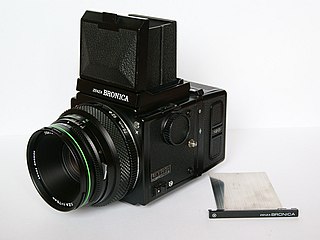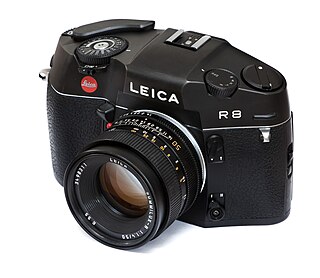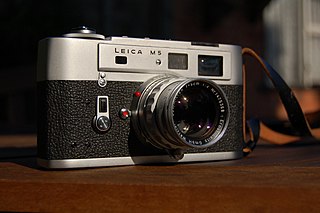
Film speed is the measure of a photographic film's sensitivity to light, determined by sensitometry and measured on various numerical scales, the most recent being the ISO system introduced in 1974. A closely related system, also known as ISO, is used to describe the relationship between exposure and output image lightness in digital cameras. Prior to ISO, the most common systems were ASA in the U.S. and DIN in Europe.

135 film, more popularly referred to as 35 mm film or 35 mm, is a format of photographic film with a film gauge of 35 mm (1.4 in) loaded into a standardized type of magazine for use in 135 film cameras.

Leica Camera AG is a German company that manufactures cameras, optical lenses, photographic lenses, binoculars, and rifle scopes. The company was founded by Ernst Leitz in 1869, in Wetzlar, Germany. The name Leica is derived from the first three letters of the founder's surname (Leitz) and the first two of the word camera: lei-ca.

Bronica also Zenza Bronica was a Japanese manufacturer of classic medium-format roll film cameras and photographic equipment based in Tokyo, Japan. Their single-lens reflex (SLR) system-cameras competed with Pentax, Hasselblad, Mamiya and others in the medium-format camera market.

The Leica M8 is the first digital camera in the rangefinder M series introduced by Leica Camera AG on 14 September 2006. It uses an APS-H 10.3-megapixel CCD image sensor designed and manufactured by Kodak.

The Leica R8 & R9 are manual focus 35 mm single-lens reflex cameras produced by the German firm Leica as the final models of their R series. Development of the R8 began in 1990: the camera was introduced at the 1996 photokina trade show, and was succeeded by the similar Leica R9 in 2002.

The Leica M mount is a camera lens mount introduced in 1954 with the Leica M3, and a range of lenses. It has been used on all the Leica M-series cameras and certain accessories up to the current film Leica M-A and digital Leica M11 cameras.

The Leica M5 is a 35 mm camera by Leica Camera AG, introduced in 1971. It was the first Leica rangefinder camera to feature through-the-lens (TTL) metering and the last to be made entirely in Wetzlar by hand using the traditional "adjust and fit" method.

The Leica M7 is a 35 mm rangefinder camera introduced by Leica AG in 2002 as a direct successor to the M6. The electronic Leica M7 is a departure from previous mechanical designs for the M series.

A mirrorless camera is a digital camera which, in contrast to DSLRs, does not use a mirror in order to ensure that the image presented to the photographer through the viewfinder is identical to that taken by the camera. They have come to replace DSLRs, which have historically dominated interchangeable lens cameras. Other terms include electronic viewfinder interchangeable lens (EVIL) cameras and compact system cameras (CSCs).

The Leica M-E is a digital rangefinder camera manufactured by Leica Camera. It was released on 17 September 2012. The M-E is Leica's first entry-level rangefinder model, with a technical specification that is nearly identical to the Leica M9, and based around the same 18MP full frame CCD sensor. It does not offer the M9's built-in USB port, but keeps pace with an identical 2 frames per second continuous shooting mode, hot shoe and Leica's classic rangefinder design. The M-E does not have a frame-lines lever, it preselects the correct frame-line for any lens when it is attached. The M-E, like the M9 and the M Monochrom, was made of brass around a magnesium chassis. The M-E is only available with an anthracite grey paint finish.

The Leica M is a full-frame digital rangefinder camera of Leica Camera AG. It was introduced in September 2012, and is the successor to the Leica M9 range of cameras. The M uses a 24-megapixel image sensor. The camera is the first M model to feature movie recording, and the first to have Live View, which allows the scene, as viewed through the lens, to be composed. The M can use most M- and R-mount lenses. Leica M cameras are made by hand in Portugal and Germany. There is also a version, the M Monochrom, with a monochrome, rather than colour, sensor.

The Leica M is a digital rangefinder camera announced by Leica Camera on November 19, 2015. The shutter and cocking mechanism are much quieter than in the earlier and higher-priced M Typ 240, and allow two frames per second to be recorded in single shot mode. The model omits the Typ 240's live view and video capabilities, and has a much simpler menu structure and one-button access to white balance settings. The Leica M has a CMOS full-frame sensor with a 24 Megapixel resolution, with an ISO of up to 6400. The usual brass camera body has been replaced with an aluminum alloy top plate, for a reduction in weight.

The Leica M10 is a full-frame digital rangefinder camera in Leica Camera AG's rangefinder M series. It accepts Leica M-mount lenses. The camera model was introduced on 19 January 2017. It is a successor to the Leica M9; and has similarities with and differences to the Leica M, Leica M, and Leica M Monochrom. There are five variants of the M10 line—the M10,M10-P,M10-D, and M10 Monochrom and M10-R.
The Leica M-A is a purely mechanical 35 mm rangefinder camera released by Leica Camera AG in 2014. The camera has no exposure meter, no electronic control, and no battery is required to operate it. The camera is Leica's first purely mechanical camera since the release of the Leica M4-P in 1981.
The Leica M-E is a digital rangefinder camera announced by Leica Camera on June 24, 2019. The Leica M-E is part of the long running Leica M mount line. It features a 24 Megapixels full-frame CMOS sensor, Leica's Maestro processor, and a 2GB buffer for sustained burst capture. Video can be captured at 1080/30p. As with all Leica M-series models, the camera is hand-built and weather-sealed. The camera is finished in "Anthracite Paint" with black leather wrap and limited to 700 units worldwide.
The Leica M Monochrom is a digital rangefinder camera manufactured by Leica Camera. It was released on 30 April 2015. The Leica M Monochrom uses a full frame 24 Megapixels CMOS sensor that, like its predecessor the Leica M Monochrom, has no color filter array. It is therefore Leica's second black and white only camera. It is essentially a monochrome only version of the Leica M. The M Monochrom offers an increase in ISO range up to ISO 25,000, a new 3 inches 921,000-dot LCD screen and live view shooting including focus peaking and 10x magnification. Also included is full HD video recording.

The Leica M-D was a digital rangefinder camera released by Leica Camera on 28 April 2016. The M-D is the second digital camera in the Leica M mount line-up without the rear LCD screen. The first such camera was the Leica M Edition 60 that founded on 16 September 2014, and was released to mark the sixtieth anniversary of its Leica M rangefinder system. Only 600 of these models were made, and were sold for about $18,000/£12,000. The M-D however was a full production model. The camera went on sale in May 2016 with a price of $5995/£4650.

The Leica M10 Monochrom is a digital rangefinder camera manufactured by Leica Camera. It was released on 17 January 2020. A black and white only successor to the Leica M Monochrom and the Leica M Monochrom. The M10 Monochrom uses a full frame 40 Megapixels CMOS sensor that has no color filter array on the sensor. The Leica M10 Monochrom is physically similar to the Leica M10 and Leica M10-P with a dedicated ISO dial on the top plate. The ISO ranges from 160 to 100,000. The M10 Monochrom has a 3" color TFT LCD monitor with 1,036,800 pixels covered with Gorilla Glass. The camera is made of all-metal die cast magnesium body, wrapped in synthetic leather covering, and brass top panel and base, with black chrome plated finish.

















